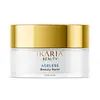What's inside
What's inside
 Key Ingredients
Key Ingredients

 Benefits
Benefits

 Concerns
Concerns

 Ingredients Side-by-side
Ingredients Side-by-side

Water
Skin ConditioningCaprylic/Capric Triglyceride
MaskingOlea Europaea Fruit Oil
MaskingGlycerin
HumectantHydrogenated Castor Oil
EmollientPolyglyceryl-4 Diisostearate/Polyhydroxystearate/Sebacate
EmulsifyingBeeswax
Emulsion StabilisingPropanediol
SolventMagnesium Sulfate
Echinacea Purpurea Extract
MoisturisingOryza Sativa Bran Extract
Skin ConditioningHoney
HumectantRoyal Jelly
Ocimum Sanctum Leaf Extract
Skin ConditioningRosmarinus Officinalis Leaf Extract
AntimicrobialHelianthus Annuus Extract
EmollientTocopherol
AntioxidantEthylhexylglycerin
Skin ConditioningPhenoxyethanol
PreservativeTriethyl Citrate
MaskingAlcohol
AntimicrobialBenzyl Salicylate
PerfumingCitrus Aurantium Dulcis Peel Oil
MaskingGeraniol
PerfumingCitrus Limon Peel Oil
MaskingCedrol
EmollientAllyl Caproate
AstringentBenzyl Acetate
MaskingTerpineol
MaskingSalvia Sclarea Oil
MaskingDimethylheptenal
PerfumingRibes Nigrum Bud Extract
PerfumingCitral
PerfumingCinnamomum Camphora Bark Oil
MaskingWater, Caprylic/Capric Triglyceride, Olea Europaea Fruit Oil, Glycerin, Hydrogenated Castor Oil, Polyglyceryl-4 Diisostearate/Polyhydroxystearate/Sebacate, Beeswax, Propanediol, Magnesium Sulfate, Echinacea Purpurea Extract, Oryza Sativa Bran Extract, Honey, Royal Jelly, Ocimum Sanctum Leaf Extract, Rosmarinus Officinalis Leaf Extract, Helianthus Annuus Extract, Tocopherol, Ethylhexylglycerin, Phenoxyethanol, Triethyl Citrate, Alcohol, Benzyl Salicylate, Citrus Aurantium Dulcis Peel Oil, Geraniol, Citrus Limon Peel Oil, Cedrol, Allyl Caproate, Benzyl Acetate, Terpineol, Salvia Sclarea Oil, Dimethylheptenal, Ribes Nigrum Bud Extract, Citral, Cinnamomum Camphora Bark Oil
Water
Skin ConditioningEthylhexyl Stearate
EmollientCaprylic/Capric Triglyceride
MaskingGlycerin
HumectantPolyglyceryl-2 Dipolyhydroxystearate
Skin ConditioningGlyceryl Oleate
EmollientC18-36 Acid Triglyceride
EmollientZinc Stearate
Cosmetic ColorantPolyglyceryl-3 Diisostearate
EmulsifyingMaris Sal
Skin ConditioningSilver Citrate
AntimicrobialMagnesium Sulfate
Phenoxyethanol
PreservativeTocopheryl Acetate
AntioxidantPanthenol
Skin ConditioningCitric Acid
BufferingTocopherol
AntioxidantEthylhexylglycerin
Skin ConditioningHelianthus Annuus Seed Oil
EmollientWater, Ethylhexyl Stearate, Caprylic/Capric Triglyceride, Glycerin, Polyglyceryl-2 Dipolyhydroxystearate, Glyceryl Oleate, C18-36 Acid Triglyceride, Zinc Stearate, Polyglyceryl-3 Diisostearate, Maris Sal, Silver Citrate, Magnesium Sulfate, Phenoxyethanol, Tocopheryl Acetate, Panthenol, Citric Acid, Tocopherol, Ethylhexylglycerin, Helianthus Annuus Seed Oil
Ingredients Explained
These ingredients are found in both products.
Ingredients higher up in an ingredient list are typically present in a larger amount.
This ingredient is an emollient, solvent, and texture enhancer. It is considered a skin-softener by helping the skin prevent moisture loss.
It helps thicken a product's formula and makes it easier to spread by dissolving clumping compounds.
Caprylic Triglyceride is made by combining glycerin with coconut oil, forming a clear liquid.
While there is an assumption Caprylic Triglyceride can clog pores due to it being derived from coconut oil, there is no research supporting this.
Learn more about Caprylic/Capric TriglycerideEthylhexylglycerin (we can't pronounce this either) is commonly used as a preservative and skin softener. It is derived from glyceryl.
You might see Ethylhexylglycerin often paired with other preservatives such as phenoxyethanol. Ethylhexylglycerin has been found to increase the effectiveness of these other preservatives.
Glycerin is already naturally found in your skin. It helps moisturize and protect your skin.
A study from 2016 found glycerin to be more effective as a humectant than AHAs and hyaluronic acid.
As a humectant, it helps the skin stay hydrated by pulling moisture to your skin. The low molecular weight of glycerin allows it to pull moisture into the deeper layers of your skin.
Hydrated skin improves your skin barrier; Your skin barrier helps protect against irritants and bacteria.
Glycerin has also been found to have antimicrobial and antiviral properties. Due to these properties, glycerin is often used in wound and burn treatments.
In cosmetics, glycerin is usually derived from plants such as soybean or palm. However, it can also be sourced from animals, such as tallow or animal fat.
This ingredient is organic, colorless, odorless, and non-toxic.
Glycerin is the name for this ingredient in American English. British English uses Glycerol/Glycerine.
Learn more about GlycerinMagnesium Sulfate is a salt. More specifically, it is an epsom salt, or the bath salt used to help relieve muscle aches.
Despite having ‘sulfate’ in the name, it isn’t a surfactant or cleansing agent like sodium lauryl sulfate. Unlike those sulfates, magnesium sulfate doesn’t have the same cleansing or foaming properties (it's simply a type of salt).
In cosmetics, Magnesium Sulfate is used to thicken a product or help dilute other solids. It is a non-reactive and non-irritating ingredient.
One study shows magnesium deficiency may lead to inflammation of the skin. Applying magnesium topically may help reduce inflammation.
You can find this ingredient in sea water or mineral deposits.
Learn more about Magnesium SulfatePhenoxyethanol is a preservative that has germicide, antimicrobial, and aromatic properties. Studies show that phenoxyethanol can prevent microbial growth. By itself, it has a scent that is similar to that of a rose.
It's often used in formulations along with Caprylyl Glycol to preserve the shelf life of products.
Tocopherol (also known as Vitamin E) is a common antioxidant used to help protect the skin from free-radicals and strengthen the skin barrier. It's also fat soluble - this means our skin is great at absorbing it.
Vitamin E also helps keep your natural skin lipids healthy. Your lipid skin barrier naturally consists of lipids, ceramides, and fatty acids. Vitamin E offers extra protection for your skin’s lipid barrier, keeping your skin healthy and nourished.
Another benefit is a bit of UV protection. Vitamin E helps reduce the damage caused by UVB rays. (It should not replace your sunscreen). Combining it with Vitamin C can decrease sunburned cells and hyperpigmentation after UV exposure.
You might have noticed Vitamin E + C often paired together. This is because it is great at stabilizing Vitamin C. Using the two together helps increase the effectiveness of both ingredients.
There are often claims that Vitamin E can reduce/prevent scarring, but these claims haven't been confirmed by scientific research.
Learn more about TocopherolWater. It's the most common cosmetic ingredient of all. You'll usually see it at the top of ingredient lists, meaning that it makes up the largest part of the product.
So why is it so popular? Water most often acts as a solvent - this means that it helps dissolve other ingredients into the formulation.
You'll also recognize water as that liquid we all need to stay alive. If you see this, drink a glass of water. Stay hydrated!
Learn more about Water